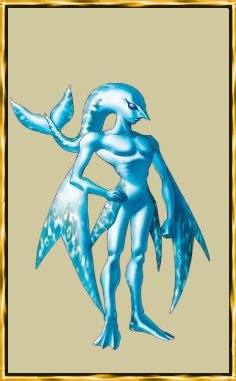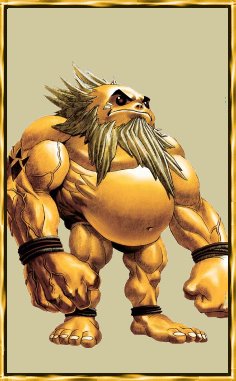Hyrule is a small country in a much larger world. However, it has its own native races, all with their own special
characteristics and skills. Here, I will define and explain each race. These days, races from other countries have
emerged in Hyrule, as have Hyrulian people emerged in other countries. For example, Hyrule did not originally home
people of dark skin, until people from hot countries such as Dalsona and Dubatio came to settle here. Some native
monsters, such as the Moblins, may possibly be counted as race, but they have been recorded in the bestiary, due
to their status as a monster.
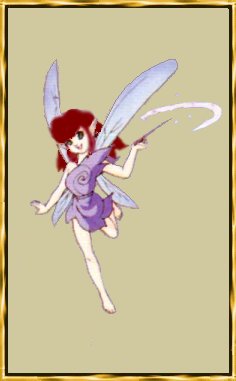
|
The Faeries
The Faeries were created along with the Humans and the Hylians, as the Goddesses last
creations. These creatures are in fact, tiny likenesses to people, and stand at the most, six inches high. They
have the delicate features and pointed ears of the Hylians, and have delicate, fly-like wings. Though usually
slight and lithe in form, it is possible for faeries to be all shapes and sizes. However, they mostly tend to
be beautiful creatures.
They were made by the Goddesses to protect the flora and fauna of Hyrule, and indeed, to this day, you will find
most faeries living in the forests, or near springs or pools. It is said the true heart of the faerie realm is in
the Ruto Forest, in West Hyrule, but they have since dispersed all around Hyrule, and beyond. These days, faeries
are rarely seen, and although they seem to have a definate preference for the Hylian people, they are still wary
and tend to keep to themselves. Indeed, after being thought of as simply objects of amusement by many people, because
of their small size, there are now far fewer in number. It is thought that there is only one faerie between every
twenty-five people.
All faeries are magically apt, and can do many powerful spells, as well as being blessed with healing skills,
which they will often bestow upon a weary traveller, due to their generous nature. This generosity extends to
wish-granting. According to legend, a beautiful wish-granting faerie lives in 'The Waterfall of Wishing'. They are
quick learners, and most also know the ancient Hylian language. Most faeries will pick a particular subject to
specialise in - rocks or herbs, for example. They love anything of beauty and enjoy celebrating most of all -
Midsummer Night is a common time to see faeries together, often in forests.
|
|
The Hylians
The Hylians are often said to have been the Goddesses 'chosen' people. Indeed, the
first ever Hylians were like images of the Goddesses themselves - tall with blonde hair and blue eyes. Nowadays, due to
intermingling with other races, Hylians come in all variations. Today, a Hylian born with blonde hair and blue eyes
is often refered to as being a 'true hylian'. Usually tall and slim, they have delicate features, long, pointed
ears and long, thick hair which never turns grey, but white. Hylians, although small in number now, live the longest
of any race.
The Hylians were originally held in high esteem by others, which has resulted in a tradition of no-one but the
Hylians sitting on the Royal Throne. Although some Hylian kings and queens did marry humans, their lineage is
fairly pure, and can be traced back over many centuries. The Hylians were the first race to master speech and
writing, although their language is now commonly out of practice. However, a few people still learn it due to the
fact that a lot of old books still exist which are written in ancient Hylian. They built the first great cities in
Hyrule, but of Hylian buildings and artifacts, little evidence of them remains.
The original Hylians had great telepathic powers, but it is now a dying skill. They are however, blessed with great
magical powers. Although Hylians are now seen as equals to Humans, they still tend to be more refined and prefer
jobs of a more artistic or creative tempermant, than that of manual work. |
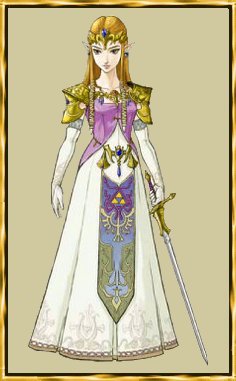 |
|
|
The Humans
Originally, Humans were the 'underdogs' of society. The Goddesses bestowed their blessing upon the Hylians, giving them
superiority over the Humans. Luckily, these days, society tends to be far more equal, although there is occasional
animosity between the two races, since they often think differently. Humans come in all shapes and sizes, but in a
rough comparison to the Hylians, Humans are more well-built, and have more rounded features than that of their
cousins. Human men often have shorter hair than Hylian men, and both Human men and women usually have both curly or
straight hair, in varying colours. They are now the most wide-spread race in Hyrule.
Humans were the first race to discover methods of farming, and such
labour has been their job for centuries. Nowadays, they are skilled in many different jobs, their strength making
them good guards and manual workers. Human women are exceptionally skilled at healing, and many do choose to follow
this path. Humans also invented the current day language of Hyrulian, which slowly replaced the difficult language
of the Hylians. Humans too, are now learning the art of magic, although it is far harder for them, than the Hylians,
who are naturally adept in this skill.
The
Humans are often said to the most friendly of all the races, and it is common to see taverns and inns owned by
Humans, due to their natural hospitality. Some Humans do feel resentful over the fact that the Hylians still
maintain the throne, but there have been no civil wars over it for several centuries. Instead, both races are
working together to stop the present evil of the wizard Ganon.
|
The Gerudo
The Gerudos are one of the most striking races from Hyrule, although it is unknown if they truly originated here.
Like the Kokiri, they are highly unusual, mostly in the fact that 99.9% of the population is female. A male Gerudo
is only born once every one-hundred years, leaving the Gerudo to travel from their isolated communities to towns
and villages to find a mate with whom to reproduce with. They are easily recognisable from their olive skin and
bright red hair. Gerudos always have amber eyes and their noses are extremely pointed. Their clothes are crafted
from light silks and muslins in bright patterns and colours and they also have a love for jewellery.
They originally inhabited a hot desert in the far southwest of Hyrule, which now does not geographically exist, due
to a shift in water levels around the country. However the Gerudos were used to travel and many also lived lives
as pirates upon boats. They worshipped a deity they called The Great Goddess and many lived in great fortresses. In
these modern times, the Gerudos now live in the country of Benlucca. It is known that the evil wizard Ganon was born
originally as Ganondorf Dragmire, and was King of the Gerudos hundreds of years ago. When he was banished to the Dark
World for his evil doings, he became the twisted, pig-creature Hyrulians are familiar with. But not all Gerudos were
bad; The Town of Nabooru is named after the Gerudo Princess who helped Hyrule fight against Ganondorf.
These beautiful women tend to be thieves by trade, and also fearless warriors. They also have a natural aptitude for magic. These days most Gerudos work as dancers and entertains, though some have fallen into a more depraved life than others, selling their bodies to live. Others find work as guards and warriors, since their skills in swordplay and archery are not easily matched. |
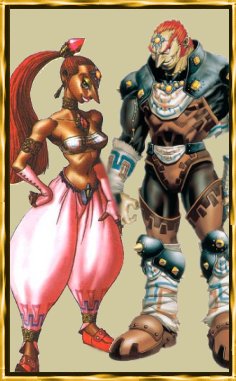
|
|
The Zora
This beautiful, fish-like race was created by the Goddesses to protect the cystal clear waters of Hyrule. Most
Zoras stood proud and tall at around six or even seven feet and were lithe and graceful. Their torso, arms
and legs were like that of a fit Hylian/human but their hands and feet were more similar to flippers, and they
had large fins attached to their elbows and hips. Their skin was a blue/silver colour and wet and glossy like the scales
of a fish. Their heads were slightly humanoid, with large blue eyes and pointed noses. From a distance, they were
often mistaken for mermaids.
The Zora lived wherever water was present but their main kingdom lay within Zora's Domain, which was located
in the far southwest of present day Hyrule, to the north of the Kokiri Forest. Behind a hidden waterfall was a
beautiful enclosed lake and many surrounding caves were the race flourished. In the sacred Zora Fountain resided
the Zora's deity, Lord Jabu-Jabu. The society was led by a monarchy. Although the Zora tended to keep to themselves,
they were once a friendly race. But over the centuries these creatures have grown bitter and evolved into unpleasant,
fire-breathing water monsters who attack upon sight.
Due to their genetic make-up the Zora are magnificent swimmers and particularly excel at diving. They can survive out
of water for short periods of time, though it is rare to see them away from their natural habitat. In times begone
the Zora were said to have enjoyed music and story-telling but little is known of their current pastimes in their
now hostile state.
|
|
The Kokiri
This child-like race originated in the Kokiri Forest and were protected by the magical deity, The Great Deku Tree.
All the Kokiri stood only a few feet tall and had delicate Hylian-like features with all different colours of hair
and eyes and builds. Their attire was always green, which helped them blend into the forest, with the males usually
wearing small, pointed floppy hats.
Though they never looked older than a ten year old child, it was said that the Kokiri could
survive for hundreds of years.
Every Kokiri was produced by The Great Deku Tree and each was assigned with a faerie guardian from birth, who
would stay with their companion until death. They lived in small communities deep within the forests of Hyrule
and each tribe would elect a leader, usually male, who would decide on each days activities. They had little
contact with the outside world, for they were unable to leave the forest. Doing so resulted in death, and they
lived so deep within the forest it was rare for such a being to be sighted.
Sadly, this charming yet strange race appeared to have died out many hundreds of years ago. Whether it was the
destruction of many of Hyrule's forests or simply evolution, the Kokiri have never been sighted or heard of for
many centuries. However their namesake lives on in Catalia, where a Hylian tribe is named after them, and the towns
of Mido and Saria both have Kokiri connections.
The Kokiri had many skills but most of all they loved to play and sing, just like normal children. Most Kokiris owned
ocarinas or flutes and were wonderful muscians. They were also very agile and dexterious and good at crafting small
weapons such as bows and slings. Though they were extremely shy and wary of outsiders, all Kokiri had warm hearts and
their child-like innocence was deceptive, for they were one of the wisest races to inhabit Hyrule over the centuries.
|
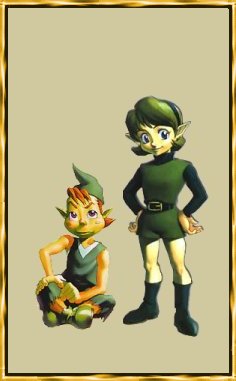 |
|
The Gorons
The goddesses created the peaceful Gorons to protect the great mountain ranges of Hyrule. This strange race
were almost like living, breathing rocks, their immense strength and power unrivalled throughout the world. The Gorons
were large of body and rounded in shape, which enabled them to curl up like boulders when asleep or in order to
protect themselves. They could be any size, from a few feet high to many hundreds of feet. Older Gorons often had
beards and males and females were indistinguishable. They survived from eating rocks, often of particular varieties
like freshy formed stone.
The Gorons lived anywhere where there were mountains and caves, but they especially thrived in heated conditions,
particulary near volcanoes. Two great Goron cities were once carved within the caverns of both Death Mountain and
Mount Kasuto. These volcanoes now lie dormant on modern times, and no Gorons have been sighted since the errupting
mountains came to slumber. Whether they have died out, or are simply hibernating until the volcanoes become active
once more is unknown. A sleeping Goron is said to look like exactly like boulder, so one wonders if the many rocks
that lie scattered within Hyrule's mountain ranges could possibly be these dormant creatures? The Mountain Town of
Darunia is named after a famous Goron King.
These creatures were unrivalled blacksmiths due to their great strength. They produced many weapons which still
exist today, especially fine swords, axes and hammers. They also cultivated bomb flowers and had a thriving trade
with the Hyrulians for their wares. In return alls they asked for was their great love; music! The Gorons loved
to dance, it is said that dancing Gorons were the causes of many earthquakes!
|
|
The Sheikah
This mysterious race were highly similar to Hylians, with their pointed ears and delicate features, and often
believed to be a rare, genetic branch who became a race in their own right. They had several features which
distinguished them from both Hylians and Humans, particularly their red eyes and grey hair. They also had a strong,
tall build, most Sheikahs typically stood around six feet tall and were quite formidable opponents. All Sheikahs
wore their sacred 'eye' symbol upon their clothing and war paint upon their faces at all times, mostly upon
the forehead and under their eyes.
Original Sheikah communities were hidden places and many ancient texts fail to mention their whereabouts. It is
well documented though that all Sheikahs trained as warriors and were sworn to protect the Hyrulian Royal
Family. The race, perhaps due to its rarity had begun to decline even before The Imprisoning War. The popular Hyrulian
name 'Impa' is actually of Sheikah heritage.
The Sheikahs were a brave and noble race with great fighting skills and they were also wise and knowledgable
scholars. They wrote many books and also dabbled in magic, due to having great mystic powers.
|
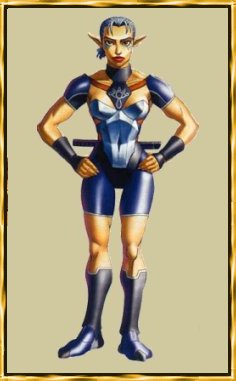 |

Go back to History Contents


